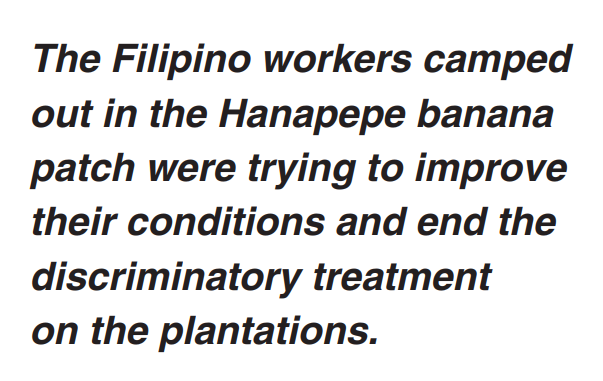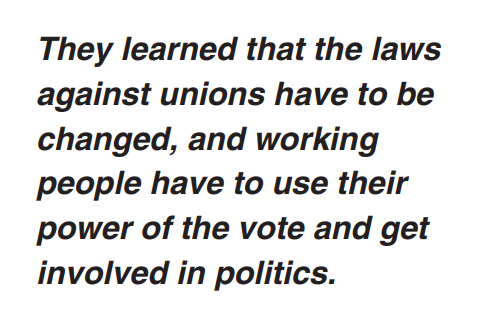On September 9, 2006, the Kauai Filipino Centennial Celebration Committee dedicated a concrete marker in the Hanapepe Town Park in memory of 16 Filipino workers killed by police during a territory-wide strike of Filipino plantation workers in 1924. Four police officers were also killed. The incident is known as the Hanapepe Massacre. Kauai Division Director Clayton Dela Cruz represented the ILWU at the ceremony and the following is based on his remarks

This is the original saying written in 1905 by George Santayana, a Spanish-born American writer and philosopher. We study and learn from history to avoid repeating past mistakes.
The 1924 Hanapepe Massacre was a very important event in Hawaii’s labor history, but most people probably never heard about it and our school children don’t learn about it. This marker is a very good thing because it will remind people about the hardships and tragedy faced by the Filipino sakada and the working people of Hawaii. Hopefully, we will learn from this history.
The Filipino workers camped out in the Hanapepe banana patch were trying to improve their conditions and end the discriminatory treatment on the plantations. They were part of the Higher Wage Movement organized in 1922 by Pablo Manlapit and George Wright, a Pearl Harbor worker with the American Federation of Labor.

Manlapit was a sakada who arrived in Hawaii in 1910 to work on a Big Island plantation. He was fired three years later when he and other Filipino workers protested a cut in their pay. Manlapit’s name was added to a list of “do not hire, troublemaker” that was distributed to the managers of all plantations. Unable to get a plantation job, Manlapit moved his family to Honolulu where he worked as a janitor and interpreter for an attorney. Manlapit studied law on his own, passed the exams, and in 1919 was the first Filipino in Hawaii licensed to practice law.
Filipino Union
Manlapit was also one of the leaders of the Filipino Labor Union which, together with the Japanese Labor Federation, struck Oahu sugar plantations in 1920. That strike failed but Manlapit continued his efforts to organize Filipino workers.
The Higher Wage Movement sought a minimum wage of $2.00 a day and a reduction of the 10 hour day to 8 hours. Most Filipino sugar workers earned only $1 a day for 10 hours of work. Manlapit and Wright held rallies and gave speeches on Oahu, Kauai and the Big Island and collected signatures on a petition. In April 1923, they sent the petitions signed by 6,000 Filipino workers to the Hawaii Sugar Planters Association (HSPA) and requested a meeting. The HSPA simply ignored them.
Unable to even meet with the HSPA, the Higher Wage Movement prepared to call a strike of Filipino workers which would start in March 1924. Only workers earning $1 a day would strike—other workers earning more would continue to work and give money to support the striking workers. The strike started on Oahu and spread to the Big Island, Maui, and to Kauai. About half of the 18,000 Filipinos working on the sugar plantations stopped work.
Hanapepe strike
The Filipino workers in Hanapepe were on strike, but it was nothing like the strikes we have today. In those days, the plantation owners controlled Hawaii’s government and they passed laws to control workers and make it almost impossible for them to organize unions. It was illegal to picket. It was illegal to interfere with a business in any way. Any group of two or more workers could be arrested for unlawful assembly. About the only thing the workers could do legally was not show up for work.
If you didn’t go to work, you were kicked out of your plantation housing, which is why the Visayan Filipino workers were camped out in the Japanese language school and banana patch in Hanapepe. At that time most of the Filipinos in Hawaii were Visayans.
On September 9, 1924, the Kauai police entered the camp to retrieve two Ilocano workers who were reportedly being held against their will. The police had recruited local hunters with highpowered rifles and stationed them on the hill above the banana patch. As the police were leaving with the two workers, a shot was fired, and in the resulting confusion the police and the deputized hunters began shooting the Filipino workers. Sixteen workers and four policemen were killed and many more were injured.
Strike broken
Heavily armed National Guard troops were sent to Kauai. The surviving workers were arrested, 76 were tried in court, and 60 received 4 year prison terms. Manlapit had nothing to do with the Hanapepe incident but he was found guilty of conspiracy and sent to Oahu Prison in 1925. He was released after 2 years on the condition he leave Hawaii. The leaders and suspected leaders of the Higher Wage Movement in all other plantations were fired and sent back to the Philippines. With their leaders in jail or deported, the Higher Wage Movement fell apart.
The “official” investigation concluded that the Filipinos started the fight, had fired first on the police, and then attacked with cane knives. More recent interviews with witnesses and survivors of the strike suggest it was more likely a tragic mistake and over reaction by the police and deputized hunters.
After 1924, the sugar planters stopped recruiting Visayans, shifted their recruitment to the Ilocos area, and rejected recruits who were educated. The planters wanted to prevent the Filipinos from uniting by dividing them as Ilocanos and Visayans. Within a few years, Illocanos were the majority of Filipinos on the plantations.

Lessons learned
It was a serious defeat for Hawaii’s workers, but it also taught them many lessons. They learned that workers had to have a union organization of their own and leadership has to be developed at all levels. They learned that a union must include all workers in the same organization, and cannot be separate organizations of Filipino or Japanese workers. They learned that the laws against unions have to be changed, and working people have to use their power of the vote and get involved in politics. In the ILWU we use this history to teach our members important lessons. One lesson is “government is very important and working people must get out and vote.”
Conditions are better today, because of the hard work and sacrifices of the Sakada, and the lessons we learned from this struggle in Hanapepe. ◆
